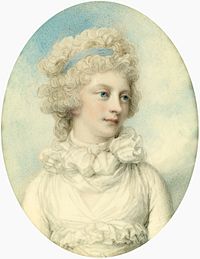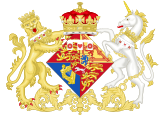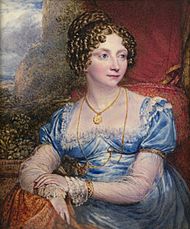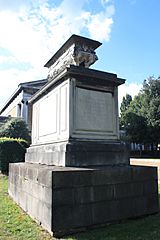Princess Sophia of the United Kingdom facts for kids
Quick facts for kids Princess Sophia |
|||||
|---|---|---|---|---|---|

Portrait by Sir Thomas Lawrence, c. 1825
|
|||||
| Born | 3 November 1777 Buckingham House, London |
||||
| Died | 27 May 1848 (aged 70) Kensington Palace, London |
||||
| Burial | 6 June 1848 Kensal Green Cemetery, London |
||||
|
|||||
| House | Hanover | ||||
| Father | George III, King of the United Kingdom | ||||
| Mother | Charlotte of Mecklenburg-Strelitz | ||||
Princess Sophia (Sophia Matilda; 3 November 1777 – 27 May 1848) was the twelfth child and fifth daughter of King George III and Queen Charlotte. She is remembered for her kind nature and the challenges she faced living as a royal princess in a strict household. There were also rumors about a secret child she was said to have had when she was young.
In her youth, Sophia was very close to her father, King George III, who often preferred his daughters over his sons. However, she and her sisters lived in fear of their mother, Queen Charlotte. The princesses received a good education but grew up in a very strict home. King George III wanted his daughters to marry suitable husbands when they were old enough. But his health problems and the Queen's wish to keep her daughters as companions prevented most of them from marrying. Because of this, Sophia and most of her sisters lived a sheltered life with their mother, which they often called a "Nunnery."
After Queen Charlotte died in 1818, Sophia and her sisters gained more freedom. In her later years, Sophia lived at Kensington Palace with her niece, Princess Victoria of Kent (who would later become Queen Victoria). During this time, a man named Sir John Conroy, who managed Princess Victoria's household, took advantage of Sophia's trust and her failing eyesight. He spent much of her money. Princess Sophia died on 27 May 1848.
Contents
Early Life of Princess Sophia
Princess Sophia was born at Buckingham House in London on 3 November 1777. She was the twelfth child and fifth daughter of King George III and Queen Charlotte. She was christened (given a religious name) on 1 December 1777 at St James's Palace.
When Sophia was born, King George III made sure his daughters and younger sons would have money. Through a special law passed by Parliament, Sophia and her older sisters were each to receive £6,000 every year. This money would start either when they married or when the King died. The royal household was very formal, even when the family was alone. For example, when the King entered a room, his daughters had to stand up. They were expected to stay quiet until he spoke to them and could not leave without his permission. Queen Charlotte tried to save money where she could. The younger princesses wore less expensive, country-made dresses and ate simple food.
Sophia's early life focused on her education. Lady Charlotte Finch was her governess, a teacher who looked after all the royal children. Queen Charlotte chose other teachers to give the princesses lessons. They learned English, French, music, art, and geography. Sophia and her sisters were also allowed to play sports and lively games with their brothers. The Queen wanted their fun activities to also be educational. Sophia and her siblings often watched plays and enjoyed special performances. Princess Sophia first appeared in public when she was six years old. She went with her parents to a special event for the composer George Frideric Handel at Westminster Abbey in 1784.
It was unusual for fathers at that time, but King George III was very involved in his daughters' early lives. He preferred his daughters to his sons. He attended their birthday parties and other special events whenever he could. He was always kept updated on their progress in their studies. A family friend once said, "I never saw more lovely children, nor a more pleasing sight than the King's fondness for them." On the other hand, Queen Charlotte made her daughters feel afraid. A historian noted that she was not a "kindly mother."
Life as an Adult Princess

By 1792, Sophia and her sister Mary began to take part in more family events. At age fourteen, Sophia made her first official appearance at court on her father's birthday, 4 June 1792. A writer named Christopher Hibbert described young Sophia as a "delightful though moody girl, pretty, delicate and passionate." Just like in her childhood, Sophia was very devoted to her father. She wrote that "the dear King is all kindness to me."
Before 1788, King George had told his daughters that he would take them to Hanover to find them suitable husbands. However, he had some worries because his own sisters had unhappy marriages. He once said, "I cannot deny that I have never wished to see any of them marry." He was happy with their company and did not want them to leave. But the King had his first period of mental illness that year, when Sophia was eleven. Sophia wrote about her father's behavior, "He is all affection and kindness to me, but sometimes an over kindness, if you can understand that, which greatly alarms me." More periods of illness happened in 1801 and 1804. This stopped any talk of marriage for his daughters. The Queen was afraid that talking about marriage, which always made the King uncomfortable, would make him ill again. Also, the Queen, tired from her husband's illness, wanted the princesses to stay close to her.
Because of this, Princess Sophia, like most of her sisters, had to live her life as a companion to her mother. The princesses were not allowed to meet anyone outside the Royal Court. They rarely saw men other than servants or helpers. They were always watched by chaperones. The girls often complained that they were living in a "Nunnery." For fun, the Queen would read sermons to them, and the princesses would practice embroidery. Sophia once wrote that their days were so "deadly dull... I wished myself a kangaroo."
Only one of her sisters, the Princess Royal, was able to marry when she was relatively young. The other princesses did have men interested in them, but Queen Charlotte usually stopped these efforts. Most of the girls wanted their own families and children. They often asked their brother, the Prince of Wales, for help. They wanted him to find them husbands, let them marry people they loved, or allow them to live outside their mother's home. Before George became regent, he had little power to help his sisters. But when he became regent in 1811, Sophia and the other unmarried princesses received more money. Their annual income increased from £10,000 to £13,000. He also supported their wish to go out into society. Queen Charlotte was very angry about these attempts. The Prince-Regent had to carefully balance things so his sisters could still have some freedom.
Rumors of a Secret Child

Because they had limited chances to meet suitable men, Sophia and some of her sisters became close to people who worked at court. Sophia became very close to her father's chief helper, Major-General Thomas Garth. He was thirty-three years older than her. He had a large purple birthmark on his face. Sophia's sister Mary jokingly called him "the purple light of love." Despite this, one lady-in-waiting noted that "the princess was so violently in love with him that everyone saw it."
Soon, rumors spread that Sophia had a secret child. Some historians believe that Sophia gave birth to a child fathered by Garth sometime before August 1800. This happened in Weymouth. Historians also write that the child, named Thomas Garth like his father, was raised by his father in Weymouth. His mother would visit him sometimes. In 1828, this Thomas Garth supposedly tried to get money from the royal family. He claimed to have secret documents from his father about his parents' relationship, but this attempt failed.
Later Years and Death
Sophia was a favorite of her niece, Princess Charlotte of Wales. The young princess liked Sophia's gentle personality and was interested in the rumors about Sophia's past. Charlotte's feelings towards her other aunts changed often. She once wrote that Sophia was so different from them in her thoughts and opinions.
The Prince Regent's efforts helped his sisters Mary and Elizabeth to marry. When Queen Charlotte died in 1818, Augusta and Sophia gained more personal freedom. However, it was too late for them to marry. Sophia inherited Lower Lodge at Windsor Great Park from her mother, which she then gave to the Prince Regent. When Princess Augusta died in 1840, Sophia inherited Clarence House and Frogmore.
After the Queen's death, Sophia lived at Kensington Palace during her final years. She lived next to her niece, Princess Victoria of Kent, who would become Queen Victoria. Princess Sophia was one of the few relatives from her father's side that Victoria saw often. Like her sister-in-law, the Duchess of Kent, Sophia trusted Victoria's manager, Sir John Conroy. She let him manage her money. Princess Sophia became part of the Duchess of Kent's social group. In return, Sophia would gather information for Conroy when he was away from Kensington Palace. Sophia also told Conroy what she heard at St. James's Palace, as she had special access to royal staff and her two older brothers. Some people thought that Conroy's ability to handle the demands of Sophia's supposed secret son made her trust him. Historians also write that Conroy took advantage of Sophia. In her last years, she was "dizzy, easily muddled" and "nearly blind." Sophia often ate meals with the household, but the Duchess of Kent did not trust her. Princess Victoria knew her aunt was gathering information, and they never became close. Sophia's wealth allowed Conroy to live a rich lifestyle. He bought a house in Kensington for £4,000 and two other properties for £18,000. Sophia also helped some people in Victoria's household get higher positions. For example, Victoria's governess, Louise Lehzen, was made a Hanoverian baroness by King George IV's orders. Conroy himself was made a Knight Commander of the Hanoverian Order.
Princess Sophia's Death
Princess Sophia had been blind for over ten years. On the morning of 27 May 1848, she became ill at her home in Kensington. Her sister Mary, her sister-in-law Queen Adelaide, and her nephew-in-law Prince Albert visited her. Sophia died at 6:30 later that day. Her sister Mary and the Duchesses of Kent and Cambridge were with her.
The princess was buried at Kensal Green Cemetery in London. She was buried right in front of the central chapel. She chose this place instead of Windsor Castle because she wanted to be near her brother, Prince Augustus Frederick, Duke of Sussex, who is buried on the opposite side of the path. After her death, it was discovered that Conroy had spent most of her money. The princess had almost no money left to leave to anyone.
Titles and Royal Symbols

Titles and Styles
- 3 November 1777 – 27 May 1848: Her Royal Highness The Princess Sophia
Royal Arms
From 1789, as a daughter of the King, Sophia used the arms of the kingdom. Her personal symbol was a white "label" with three points. The middle point had a red heart, and the outer points each had a red rose.
See also
 In Spanish: Sofía del Reino Unido para niños
In Spanish: Sofía del Reino Unido para niños





